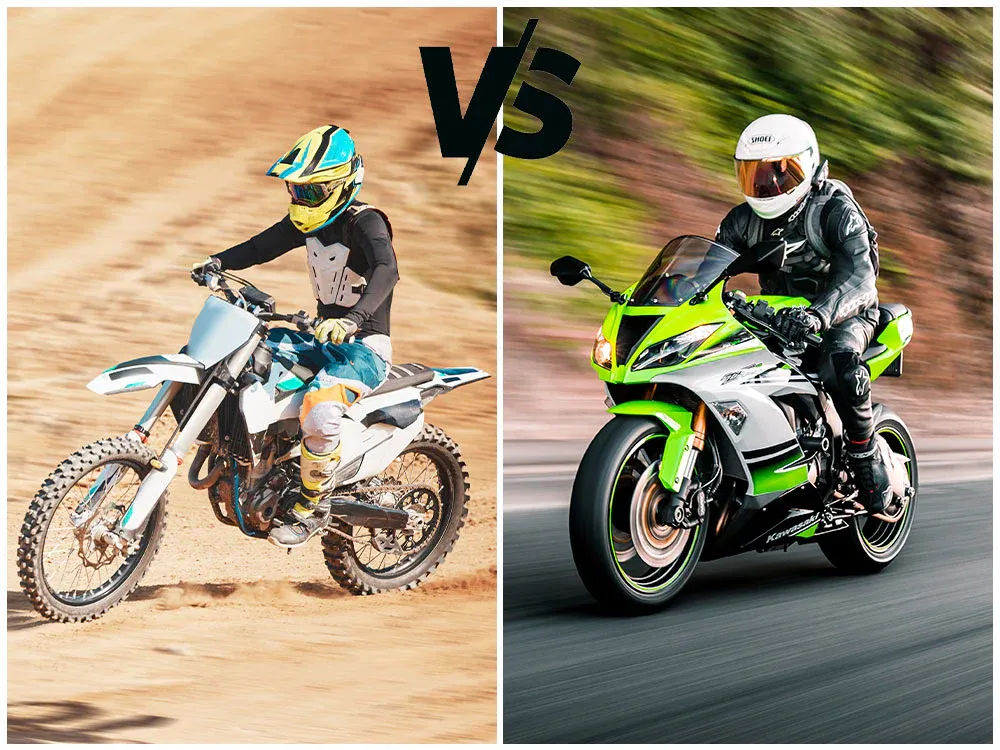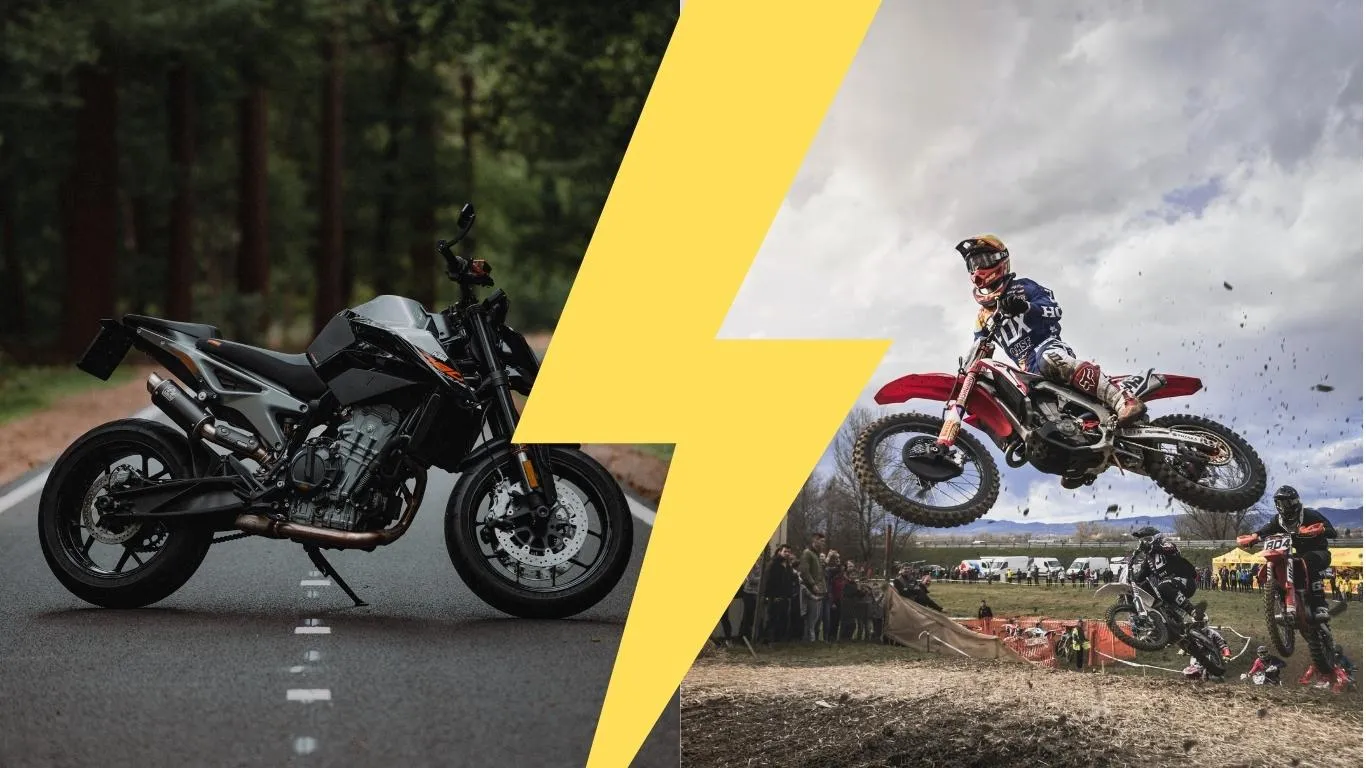Street Bikes vs. Dirt Bikes: Which One Is Right for You?

Anúncios
When choosing between Street Bikes vs. Dirt Bikes, the decision hinges on more than just adrenaline.
Each offers a distinct riding experience, shaped by terrain, lifestyle, and intent.
This guide dives deep into the nuances of both, helping you decide which aligns with your riding dreams.
Anúncios
With the motorcycle market evolving—projected to hit $145 billion globally by 2027, per Statista—the stakes for picking the right bike have never been higher.
So, what’s the smarter choice for you?
Additionally, understanding your riding preferences and local regulations can significantly influence your decision.
Being informed is the first step toward making a confident choice.
The Core of Street Bikes: Speed, Style, and Pavement
Picture a sleek machine slicing through city streets, its engine purring with precision.
Street bikes are engineered for paved roads, prioritizing speed, agility, and aesthetics.
From sport bikes built for corner-carving to cruisers designed for long, laid-back rides, they cater to diverse riders.
Their low-profile tires grip asphalt, and advanced suspension systems smooth out urban imperfections.
Take Jake, a 32-year-old graphic designer from Seattle.
He rides a Yamaha MT-07, a street bike that balances power and practicality.
Jake commutes 20 miles daily, weaving through traffic and hitting the highway for weekend getaways to the Pacific Coast.
His bike’s fuel efficiency—around 58 mpg—saves him money, and its upright riding position keeps him comfortable.
For Jake, street bikes are about blending utility with exhilaration.
Yet, street bikes demand respect.
High speeds amplify risks, especially in urban environments.
The National Highway Traffic Safety Administration (NHTSA) reports that motorcyclists are 28 times more likely to die in crashes than car occupants per mile traveled.
Proper gear and defensive riding are non-negotiable.
Maintenance is another factor; street bikes often require frequent servicing due to their complex electronics and high-performance parts.
Moreover, joining local riding groups can enhance your experience and provide valuable safety tips.
Community support can make a significant difference in your riding journey.
Dirt Bikes: Unleashing the Wild
Now, imagine tearing across a muddy trail, tires kicking up dust as you conquer a steep incline.
Dirt bikes are rugged rebels, built for off-road adventures.
Lightweight frames, knobby tires, and long-travel suspension let them tackle rocks, sand, and jumps.
They’re less about refinement and more about raw, unfiltered fun.
Consider Maria, a 27-year-old park ranger in Colorado.
She rides a KTM 350 EXC-F, a dirt bike that thrives on rocky trails near Boulder.
On weekends, Maria explores backcountry paths, her bike’s nimble handling letting her navigate tight switchbacks.
The physicality of off-road riding—standing, leaning, and muscling the bike—doubles as a workout.
For Maria, dirt bikes are a ticket to nature’s playground.
However, dirt bikes aren’t without challenges.
They’re not street-legal in most states without modifications, limiting their versatility.
Trail access can also be an issue; public lands often restrict motorized vehicles, forcing riders to seek designated areas.
Maintenance is relentless—mud, dust, and jumps punish components, demanding regular upkeep.
Still, the trade-off is a visceral connection to the terrain that street bikes can’t match.
Additionally, participating in organized trail rides can enhance your off-road experience and provide a sense of community.
Engaging with fellow dirt bike enthusiasts enriches your riding adventures.
Comparing the Two: A Tale of Purpose
Choosing between Street Bikes vs. Dirt Bikes is like picking between a sports car and a mountain bike—each excels in its domain.
Street bikes thrive on predictability, offering stability and speed on paved surfaces.
Dirt bikes embrace chaos, built to absorb shocks and handle unpredictable terrain.
Your choice depends on where you ride, how you ride, and what you value.
Let’s break it down with a quick comparison:
| Feature | Street Bikes | Dirt Bikes |
|---|---|---|
| Terrain | Paved roads, highways | Off-road trails, dirt, sand |
| Speed | Higher (up to 150+ mph for sport bikes) | Lower (typically 50-80 mph) |
| Weight | Heavier (400-600 lbs) | Lighter (200-300 lbs) |
| Maintenance | Moderate, complex electronics | High, due to dirt and wear |
| Street Legality | Yes | Often no, unless modified |
This table highlights functional differences, but lifestyle matters too.
Street bikes suit urban commuters or long-distance tourers who crave connectivity and convenience.
Dirt bikes appeal to thrill-seekers and nature lovers willing to trade practicality for adventure.
Moreover, considering your long-term riding goals can help clarify your choice.
Reflecting on your aspirations can lead to a more fulfilling riding experience.
+ Women in Motorcycling: Breaking Stereotypes
Cost and Accessibility: The Practical Angle
Money talks, and motorcycles aren’t cheap.
Street bikes vary widely—entry-level models like the Honda Rebel 300 start at $4,800, while premium sport bikes like the Ducati Panigale V4 exceed $24,000.
Dirt bikes are generally cheaper, with models like the Yamaha YZ125 starting at $6,500, though high-end options like the Husqvarna FC 450 can hit $11,000.
Used markets for both can shave thousands, but beware of hidden repair costs.
Accessibility is another hurdle.
Street bikes require a motorcycle license, obtainable through a DMV test or training course.
Dirt bikes, when ridden off-road, often don’t need a license, but street-legal conversions demand one.
Insurance is pricier for street bikes due to their road exposure, averaging $500-$1,500 annually versus $100-$300 for off-road-only dirt bikes.
Training is critical for both.
Street bike riders benefit from courses like the Motorcycle Safety Foundation’s Basic RiderCourse, which teaches road survival skills.
Dirt bike riders, meanwhile, can attend off-road schools like the Yamaha Champions Riding School, mastering techniques for jumps and slides.
Investing in training reduces risk and boosts confidence.
For more information on motorcycle insurance and costs, check out Progressive.
Understanding the financial aspects of your choice can help you plan accordingly.

Performance and Technology: The 2025 Edge
Modern motorcycles are tech marvels, and Street Bikes vs. Dirt Bikes showcase different innovations.
Street bikes lean into electronics—think traction control, ABS, and ride modes.
The 2025 Kawasaki Ninja ZX-10R, for instance, features a quick-shifter for seamless gear changes and a TFT display for real-time data.
These systems enhance safety and performance, especially at high speeds.
Dirt bikes prioritize durability and simplicity.
The 2025 Honda CRF450R boasts a hydraulic clutch for smoother shifts and a reinforced frame for jump landings.
Some models now include basic electronics, like selectable engine maps, but they avoid the complexity of street bikes to keep weight down.
This simplicity makes dirt bikes easier to repair in the field—a boon for remote trails.
Performance-wise, street bikes dominate in raw power.
A liter-class sport bike can hit 0-60 mph in under 3 seconds, rivaling supercars.
Dirt bikes, while less powerful, excel in torque, delivering instant grunt for climbing hills or clearing obstacles.
Your preference—speed or agility—shapes the choice.
Additionally, staying updated on technological advancements can enhance your riding experience.
Embracing new technology can improve safety and performance on the road or trail.
Lifestyle and Culture: What’s Your Vibe?
Beyond specs, motorcycles are a lifestyle.
Street bike culture spans urban cafes, where riders showcase custom cruisers, to racetracks, where sport bike enthusiasts chase lap times.
Events like Sturgis Motorcycle Rally draw thousands, blending camaraderie with chrome.
Street bike riders often value aesthetics, with brands like Harley-Davidson selling a rebellious image.
Dirt bike culture is grittier, rooted in motocross tracks and remote trails.
Riders bond over shared challenges—fixing a flat in the desert or nailing a double jump.
Events like the Red Bull Romaniacs showcase the sport’s extreme side, attracting hardcore adventurers.
Dirt bike riders embrace the mess, valuing experience over appearances.
Which vibe calls to you?
Are you drawn to the polished roar of a street bike or the raw, muddy thrill of a dirt bike?
Moreover, engaging with local riding communities can enhance your connection to the culture.
Finding your tribe can enrich your motorcycle journey.

Safety and Risk: Facing the Reality
Riding is inherently risky, but Street Bikes vs. Dirt Bikes carry different dangers.
Street bikes face traffic, where a distracted driver can spell disaster.
Helmets, armored jackets, and gloves are musts, yet crashes at 70 mph are unforgiving.
Dirt bikes, while slower, invite injuries from falls or jumps.
Motocross riders often wear neck braces and knee guards to mitigate risks.
A 2023 study by the Insurance Institute for Highway Safety found that off-road crashes, while less fatal, lead to more non-fatal injuries due to terrain hazards.
Training and gear are your best defenses, regardless of bike type.
Complacency is the real enemy—respect the machine, and it’ll reward you.
Additionally, understanding the specific risks associated with your riding environment can enhance your safety.
Being aware of your surroundings is crucial for safe riding.
++ How to Ride a Motorcycle in Bad Weather: A Survival Guide for Smart Riders
Making the Choice: A Decision Framework
Here’s a practical guide to decide:
| Question | Street Bike | Dirt Bike |
|---|---|---|
| Where do you ride? | Urban, highways, paved roads | Trails, forests, motocross tracks |
| What’s your budget? | $5,000-$25,000 | $6,000-$12,000 |
| Do you value speed or agility? | Speed, precision | Agility, torque |
| Urban or rural lifestyle? | Urban, suburban | Rural, access to trails |
| Maintenance tolerance? | Moderate, dealer-based | High, hands-on |
Reflect on these questions.
If you’re like Jake, craving pavement and practicality, a street bike fits.
If Maria’s off-road passion resonates, a dirt bike is your match.
Hybrids like dual-sport bikes offer a middle ground, blending street legality with off-road capability, but they compromise on both fronts.
Additionally, considering future riding plans can help solidify your choice.
Thinking long-term can lead to a more satisfying riding experience.
The Final Throttle: Your Ride, Your Rules
Choosing between Street Bikes vs. Dirt Bikes isn’t just about specs—it’s about soul.
Street bikes are your wings on asphalt, blending speed, style, and accessibility.
Dirt bikes are your escape, offering raw adventure and a bond with the earth.
Both deliver freedom, but in different flavors.
Test-ride both if you can; the saddle tells no lies.
In 2025, with tech advancing and communities thriving, there’s never been a better time to ride.
So, what’s stopping you from hitting the road—or the trail—today?
Moreover, taking the time to reflect on your experiences can help you make the most of your riding journey.
Embrace the ride, and let it shape your adventures.
